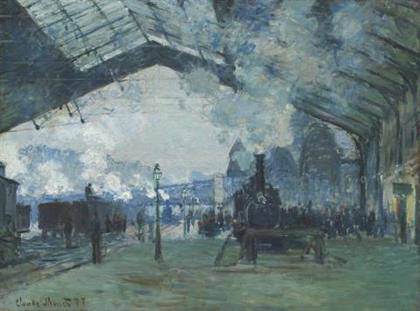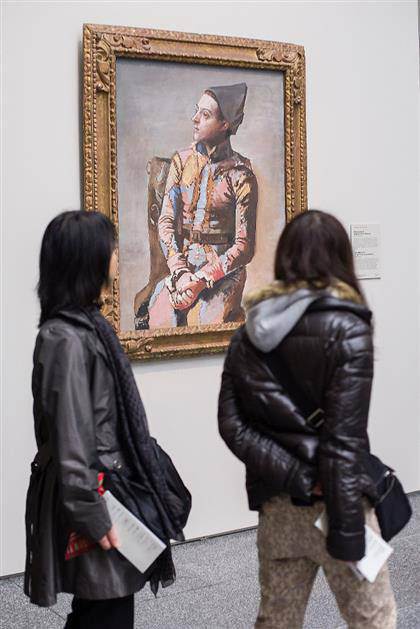
Claude Monet (1840-1926)
Saint-Lazare Station, Arrival of the Normandy Train, 1877
Art Institute of Chicago

Monet and the Birth of Impressionism
Exhibition view
Painting: Monet’s “Hôtel des Roches Noires, Trouville”, 1870
‘Monet and the Birth of Impressionism’ at the Städel From 11 March to 21 June 2015, Frankfurt’s Städel Museum is presenting a major exhibition on ‘Monet and the Birth of Impressionism’, featuring one hundred masterworks.]]>
Source: Städel Museum
World-famous loans are on view, for example Monet’s “La Grenouillère” (1869) from the New York Metropolitan Museum of Art, his “Boulevard des Capucines” (1873) from the Nelson-Atkins Museum of Art in Kansas City, and “The Luncheon: decorative panel” (ca. 1873) and “Camille on Her Deathbed” (1879), both from the Musée d’Orsay in Paris. The exhibition, which is one of the highlights of the ̈200 Years Städel ̈ anniversary programme, inquires into how Impressionism came about and the extent to which this approach to painting manifests contemporary visual experience. In addition to some fifty paintings by Claude Monet, works by numerous other Impressionists are also on display, including important examples by Auguste Renoir, Edgar Degas, Berthe Morisot, Camille Pissarro and Alfred Sisley. The anniversary exhibition bears a direct connection to the history of the Städel Museum’s own holdings: as early as the beginning of the twentieth century, then director Georg Swarzenski (1876–1957) came out passionately in favour of acquiring French painting ‒ which now represents one of the chief focuses of the museum’s collection.
Taking as its point of departure Claude Monet’s painting “The Luncheon” (1868/69) ‒ a key work of early Impressionism that the Städel is fortunate enough to have in its holdings ‒ and the museum’s superb collection of early Impressionist works by Auguste Renoir, Édouard Manet, Edgar Degas, Alfred Sisley and Paul Cézanne, the exhibition shows how the Impressionists found their way to the dissolution and dematerialization of their pictorial motifs. From a multifaceted perspective, the visitors will learn about the various conditions that led to the birth of Impressionism and the radical change that came about in the relationship between pictorial content and form in the paintings produced by this important movement. Impressionism challenged the visual habits of the time in a completely new way ‒ and met with a wide variety of responses, as is evidenced by contemporary caricatures to be presented alongside works of Impressionist painting and photography.
“Works from the early days of Impressionism are rare and precious. All the more delighted are we that we have been able to realize such a complex and spectacular special exhibition as a prelude to our anniversary year, and have the opportunity to present loans from all over the world side by side with central works from the Städel collection. The exhibition and research project will undoubtedly be yet another highlight in the Städel’s two-hundred-year history”, comments Max Hollein, the director of the Städel Museum.
Related content
Monet’s paintings of the River Seine at MFAH Houston (exhibition, 2014)
Follow us on:


